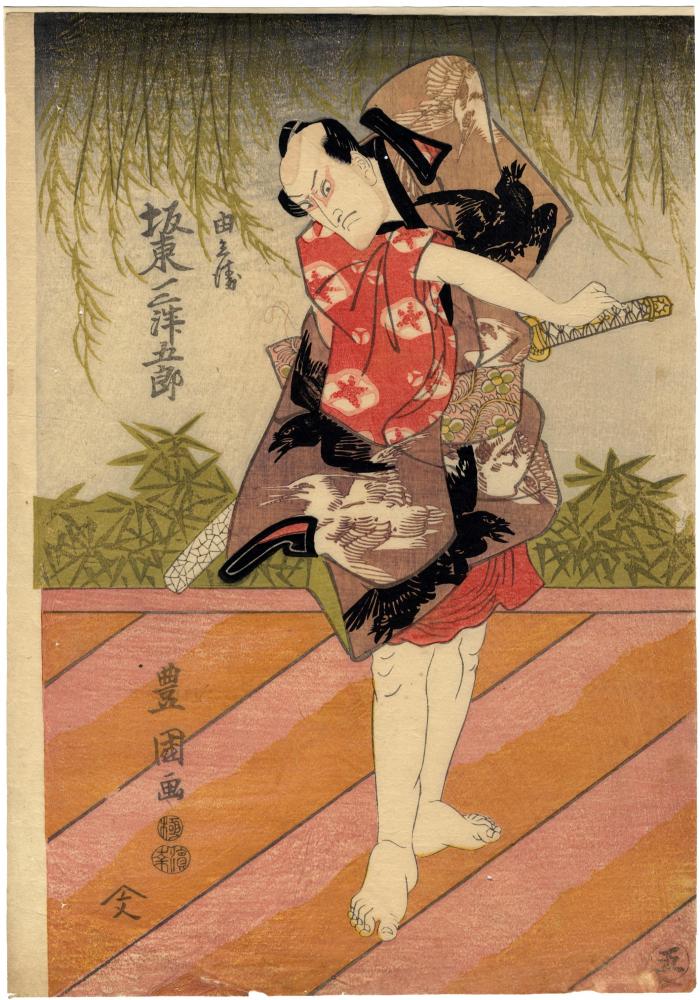Utagawa Toyokuni I (初代歌川豊国) (artist 1769 – 02/24/1825)
Bandō Mitsugorō (坂東三津五郎) as the otokodate (Ume) Yoshibei (由兵衛) from the play 'The Gion Festival Chronicle of Faith' (Gion Sairei Shinkōki - 祇園祭礼信仰記) - this is number 5 (五) from this series
05/1815
10.25 in x 14.5 in (Overall dimensions) Japanese woodblock print
Signed: Toyokuni ga ((豊国画))
Publisher: Tsujiokaya Bunsuke
(Marks 548 - seal 01-107)
Censors seal: kiwame and Hamako
Number 5 (五) in the lower right corner
Lyon Collection - Kunihiro print of Ume Yoshibei
Ritsumeikan University - another panel from this composition
Lyon Collection - Shūshō print of Chōkichi and Yoshibei This print represents a kabuki production from 5/1815.
The figure of Yoshibei, an otokodate, standing on the stage is about to draw his sword. The number five (五) printed in a circle in the lower right of this print should give us an idea of the size of this original multi-panel artwork - a pentaptych. So far we have only been able to find two of the prints in this group, but we will keep looking.
The birds decorating the garments worn by Bandō Mitsugorō indicate that this character is Ume no Yoshibei (梅由兵衛).
****
"Ume Yoshibei is one of the leading characters in the play Suda no haru geisha katagi (Revenge of the Geisha at Suda in Spring), also known as Ume no Yoshibei, written by Namiki Gohei I for the Kabuki stage in 1796. The story is based on an actual robbery and murder that took place in Osaka during the Genroku period (1688-1703)."
"Ume Yoshibei, a hot-tempered Robin Hood-like Edo townsman (otoko-date), is helping a geisha to raise money to redeem a stolen family treasure, a poem card. His wife, Ko-Ume, secretly ask her younger brother, Chōkichi, for the money. Chōkichi asks his girlfriend, O-Kun, the daughter of his employer for the money requested by his sister. However, because of an erroneously delivered love letter, O-Kun, becomes angry with Chōkichi, who thereupon steals the money. When that evening Chōkichi, on his way to Ko-Ume's house, passes along the banks of the Ō River, he is attacked by a robber. Fortunately, Yoshibei, who does not recognize his brother-in-law, comes to the rescue. When Yoshibei learns that the boy carries a purse with money, he asks for it as a loan. Chōkichi refuses, and Yoshibei, desperate, kills him on the spot. In the meantime the crook Gengobei has picked up the purse and tries to get Yoshibei to give him his wife and the money in exchange for the stolen (actually counterfeited) family treasure. In the end, Yoshibei, provoked beyond measure, kills may of his adversaries, eventually retrieving the genuine poem card."
Quoted from: The Hundred Poets Compared: A Print Series by Kuniyoshi, Hiroshige, and Kunisada by Henk J. Herwig and Joshua S. Mostow, Hotei Publishing, 2004, page 192.
Tsujiokaya Bunsuke (辻岡屋文助) (publisher)
Bandō Mitsugorō III (三代目坂東三津五郎: 11/1799 to 12/1831) (actor)
actor prints (yakusha-e - 役者絵) (genre)
Ume no Yoshibei (梅の由兵へ) (role)
Gion Sairei Shinkōki (祇園祭礼信仰記) (author)
Otokodate - chivalrous men (男伊達) (author)
